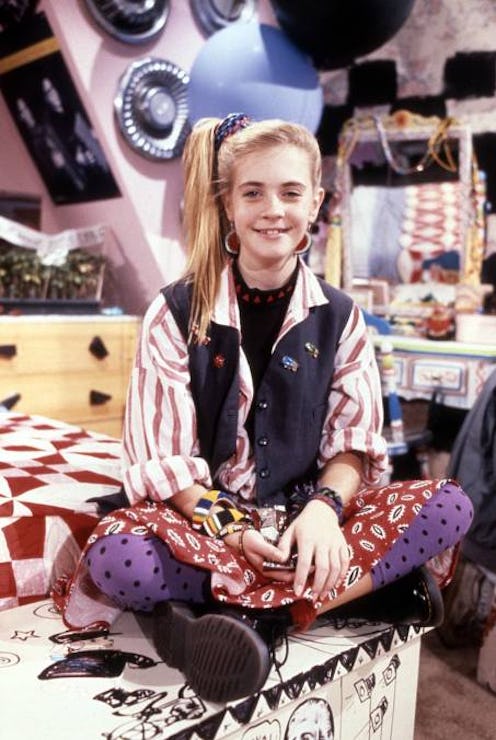Entertainment
'Clarissa Explains It All' Was Revolutionary

Honestly, who was more of a television darling than the eponymous lead of the hit Nickelodeon show Clarissa Explains it All? Answer: no-one. Because if there was one character —and more specifically one program that wasn't afraid to break the mold at a time when children's networks basically ruled our worlds — it was Clarissa Darling and her show, Clarissa Explains it All. The show debuted in 1991 (cue the gasps!) and thanks to its witty dialogue, interesting graphics, and daring depiction of a female adolescent, it became an instant classic.
Clarissa, played by a fetus version of Melissa Joan Heart, was essentially in charge of teaching me everything I needed to know about life, fashion, and how to be unapologetically yourself. She really did explain it all. Little did I know though, how much of a game changer the show itself was at a more macro level. The idea at its base was not a necessarily new one — a teenager finding her way in the world — but the execution was certainly different.
Thankfully the show was backed by creators and writers that weren't afraid to take risks and push the boundaries. For most of its viewers, Clarissa Explains it All was a refuge amongst the typical hum drum monotony of "adolescent TV" in the late '80s and early '90s. If anything, the show existed in its own little world, and for 30 minutes every week, it allowed us inside. Here are nine ways that Clarissa Explains it All proved to be a renegade of early '90s television.
1. It Was The First Sitcom for Nickelodeon
At the time Clarissa Explains it All premiered, Nickelodeon was airing mostly cartoons and game shows — in fact, according to Buzzfeed, Clarissa was the first sitcom on the channel. (The only similar predecessor to Clarissa Explains it All was the Western-inspired Hey Dude, but that doesn't quite count as a sitcom.)
2. It Was The First Female-Led Sitcom For Nickelodeon
Following Hey Dude's premiere in 1989, Clarissa Explains it All creator Mitchell Kriegman thought it was time for a female centric show. He explained to Mental F loss in a 2014 interview, "I knew that [Nickelodeon] needed a girl. They had all this boys stuff, and they weren’t seeing girls in the modern way that girls existed." Hell yes, Kriegman, hell yes.
3. Clarissa Was A Complex And Multifaceted Female
Not only was Clarissa the first female to have her own show on Nickelodeon, she was one of the first female teens to really be depicted with nuance and complexity. For instance: She was interested in fashion, but she had a pet alligator named Elvis. She was intelligent and analytical, but loved playing video games. Layers, people!
4. Clarissa Had A "Boy Friend" That Wasn't Her "Boyfriend"
Kriegman and the show introduced a different kind of teen relationship that hadn't been explored too much in adolescent television up until this point: That of a male and female friendship. Sam was pretty much the coolest BFF ever, and the definite yin to Clarissa's yang. The duo went together better than his tie-dye shirts and neon shorts.
5. The Depiction Of Clarissa's Family Was Earnest
The show never tried to paint Clarissa's family as perfect. In fact, a large portion of the show's story lines revolved around a brother and sister rivalry. Clarissa even talked back to her parents! It felt real.
6. It Broke The Fourth Wall
Clarissa talked to her audience in the most naturalistic way possible: Right at you. This definitely heightened the feeling that she was either your BFF, or cooler older sister. When she shared her thoughts about what was going on in each episode, it forced the audience to see the perspective of a teen girl, and that was an important moment for television.
7. The Show Had Graphics
Not only was the use of graphics on TV during the early '90s revolutionary (read: difficult), but Clarissa Explains it All's incorporation of different medias paved the way for future TV shows to adopt the same kind of interesting juxtapositions. Case in point: Lizzie McGuire's beloved digitized alter-ego. Yeah, it's likely she can thank Clarissa for that.
8. The Storyline Always Reversed The Typical Family Sitcom Format
Usually the main story in a family sitcom episode revolves around something moral and with weight, which is followed by a less serious and lighter second story. In Clarissa Explains it All, the show creator decided to reverse that: For instance, in the episode titled "School Picture," the main story revolves around what Clarissa will wear for her photos, while the secondary story involves family drama.
9. The Show Wasn't Dumbed Down
Although Clarissa might have thrown in references that went over some viewers' heads (she once quoted Karl Marx, guys), we were never placated in watching her. She spoke to us like we were her peers, and even if we didn't understand everything she said, we were sure as hell listening.
At a time where the structure and dynamics of television were changing, Clarissa Explains it All was a revelation. With its female protagonist, fine tuned story lines, and sharp dialogue, the show set some major precedents. Let's just say it was a tough act to follow.
Images: Nickelodeon; Giphy (9)